The need for high technology for, among other things, precision medicine and sustainable, renewable energy is growing. To achieve a healthier and more sustainable society, we need to strengthen research resources and infrastructure. But how do we do this in the best way, to achieve maximum synergy effects and attract the best researchers?
Nanotechnology can place Sweden at the forefront of sustainable energy and new ways of finding and curing diseases. Welcome to see a short movie with NanoLund’s deputy director Maria Messing and Johan Wester, followed by a talk with Kerstin Jakobsson, former CEO of Medicon Village, Anders Mikkelsen, director of NanoLund, Camilla Modéer, member and senior adviser, Royal Academy of Engineering Sciences (IVA) and Viktor Öwall, pro-vice-chancellor for infrastructure and digitalization, Lund University.
The talk is held in Swedish but will be texted in English later on. It is part of Lund University’s contribution to “Almedalsveckan”, an annual democratic place for dialogue, exchange, and unexpected meetings.
|
|
|
 |
 |
Time and place: October 12 at the Scandic Star Hotel, Glimmerv 5 in Lund. The program features invited and contributed talks, posters covering all areas of nanoscience, and dinner. Topics: Radiation from microwaves to visible light and X-rays to study the nanoworld • Generation and detection of radiation by nanodevices • Systems from semiconductors to nanoparticles and nanowires and biologically related objects. We hope to see you all!
|
|
|
2020 turned out to be a year like no other. It challenged us, but we found ways to keep up our good work. We have compiled NanoLund’s performance this special year in our annual report.
Not only did NanoLund find ways to continue forwards despite ever-changing restrictions – but we also did our best to contribute with research on covid-testing, mapping the way viruses spread, and much more.
Our publications show a wide range of interesting topics from fundamental quantum phenomena, measuring and mimicking neural structures, extreme materials control, and industrially relevant processes. Sustainability has been in focus in much research, dealing with the world’s energy challenges as well as use for medical sensors and diagnostics with an impact for the many people.
In the Annual Report for 2020, which just arrived from the print shop, you can see our new stats, and read about some of the highlights.
|
|
In 2014, NanoLund was awarded in total 3.2 M€ by the European Commission to train as many as twelve PhD students in the area of nanoscale materials for sustainable energy applications. After the graduation of Hailiang Xu, we proudly report that all twelve have graduated, and have produced a vast amount of new scientific findings on the way.
|
|
|
Researchers from NanoLund, the Russian Academy of Science, and the Technical University of Dresden in Germany have developed a new methodology for the study of lead halide perovskites.
“Mapping a perovskite film using our new method is like taking its fingerprints – it provides us with a great deal of information about each individual sample,” says Ivan Scheblykin.
“Interestingly, each map resembles the shape of a horse’s neck and mane, leading us to fondly refer to them as ‘perovskite horses’, which are all unique in their own way.”
|
|
|
In a new study presented in the research journal Chem, the Swedish-Turkish research team has presented revealing results.
“We have studied behaviour of the plexcitons all the way from absorption of photons until their energy is dissipated as heat”, says Donatas Zigmantas.
|
|
Engaging more than 50 research groups in the faculties of engineering, science, and medicine, NanoLund is a strategic research area funded by the Swedish Government and Sweden’s largest research environment for nanoscience and nanotechnology.
We contribute to societal and sustainability challenges, for example in health and clean energy, using the tools of nanoscience and nanotechnology. To this end, our research topics range from materials science and quantum physics to applications in energy, electronics, photonics, personalized medicine, and nanosafety. In the research portal, our recent scientific articles from NanoLund researchers are found – most recent articles on tops.
|
|
What is NanoLund? What are the scientific possibilities? What does it mean to be involved in NanoLund? How is it organized? What are the benefits? How can I find collaborators? How can I use equipment in other labs? Tips and tricks for PhD students and postdocs?
September 20, we greet newcomers to NanoLund. The events are open to anyone who has joined NanoLund recently and all who always wanted to know more.
|
|
| Wanted: five post-docs/researchers and one doctoral student. Topics range from microfluidics and separation of extracellular vesicles, interaction of antimicrobial peptides with bacteria, modeling of molecular motors to ultrawide bandgap semiconductor materials. Work in an international, highly visible nanoscience center, exceptional scientific opportunities, and career development as well as state-of-the-art infrastructure! |
|
|
Leading California-based company within quantum dot light-emitting materials and technology, Nanosys, has acquired the NanoLund spin-off company Glo AB – thus forming one of the world’s leading companies in the field of displays.
|
|
|